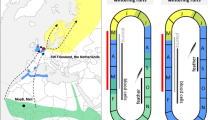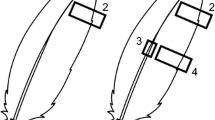Abstract
Blood and feathers are the most targeted tissues for isotopic investigations in avian ecology, primarily because they can be easily and non-destructively sampled on live individuals. Comparing blood and feather isotopic ratios can provide valuable information on dietary shifts, trophic specialization and migration patterns, but it requires a good knowledge of the isotopic differences between the two tissues. Here, δ13C and δ15N values of whole blood (in blood cells of a few species) and simultaneously grown body feathers were measured in seabird chicks to quantify the tissue-related isotopic differences. Seabirds include 27 populations of 22 wild species that were sampled in 2000–2008, and a review of the literature added 8 groups (including adult birds) to the analysis. The use of a large data set that overall encompasses wide δ13C and δ15N ranges allowed us to depict for the first time accurate relationships between blood and feather isotopic ratios across avian taxa. Blood was impoverished in 13C and generally in 15N compared with feathers. Both mean δ13C and δ15N values of feathers and blood were highly positively and linearly related [feather δ13C = 0.972 (±0.020) blood δ13C + 0.962 (±0.414), and feather δ15N = 1.014 (±0.056) blood + 0.447 (±0.665), respectively; both P < 0.0001]. The regressions should be applied to mathematically correct feather or whole blood δ13C and δ15N values when comparing isotopic ratios within and between ecological studies on birds.

Similar content being viewed by others
References
Bearhop S, Teece MA, Waldron S, Furness RW (2000) Influence of lipid and uric acid on δ13C and δ15N values of avian blood: implications for trophic studies. Auk 117:504–507
Bearhop S, Waldron S, Votier SC, Furness RW (2002) Factors that influence assimilation rates and fractionation of nitrogen and carbon stable isotopes in avian blood and feathers. Physiol Biochem Zool 75:451–458
Bost CA, Jouventin P (1991) The breeding biology of the gentoo penguin Pygoscelis papua on the Crozet Islands. Ibis 133:14–25
Bugoni L, McGill RAR, Furness RW (2008) Effects of preservation methods on stable isotope signatures in bird tissues. Rapid Commun Mass Spectrom 22:2457–2462
Caut S, Angulo E, Courchamp F (2009) Variation in discrimination factors (Δ15N and Δ13C): the effect of diet isotopic values and applications for diet reconstruction. J Appl Ecol 46:443–453
Cherel Y (2008) Isotopic niches of emperor and Adélie penguins in Adélie Land, Antarctica. Mar Biol 154:813–821
Cherel Y, Hobson KA, Bailleul F, Groscolas R (2005a) Nutrition, physiology, and stable isotopes: new information from fasting and molting penguins. Ecology 86:2881–2888
Cherel Y, Hobson KA, Hassani S (2005b) Isotopic discrimination between food and blood and feathers of captive penguins: implications for dietary studies in the wild. Physiol Biochem Zool 78:106–115
Cherel Y, Hobson KA, Weimerskirch H (2005c) Using stable isotopes to study resource acquisition and allocation in procellariiform seabirds. Oecologia 145:533–540
Cherel Y, Le Corre M, Jaquemet S, Ménard F, Richard P, Weimerskirch H (2008) Resource partitioning within a tropical seabird community: new information from stable isotopes. Mar Ecol Prog Ser 366:281–291
Cruz LL, McGill RAR, Goodman SJ, Hamer KC (2012) Stable isotope ratios of a tropical marine predator: confounding effects of nutritional status during growth. Mar Biol 159:873–880
Dalerum F, Angerbjörn A (2005) Resolving temporal variation in vertebrate diets using naturally occurring stable isotopes. Oecologia 144:647–658
Evans Ogden LJ, Hobson KA, Lank DB (2004) Blood isotopic (δ13C and δ15N) turnover and diet-tissue fractionation factors in captive dunlin (Calidris alpina pacifica). Auk 121:170–177
Federer RN, Hollmen TE, Esler D, Wooller MJ, Wang SW (2010) Stable carbon and nitrogen isotope discrimination factors from diet to blood plasma, cellular blood, feathers, and adipose tissue fatty acids in spectacled eiders (Somateria fischeri). Can J Zool 88:866–874
Fort J, Cherel Y, Harding AMA, Welcker J, Jakubas D, Steen H, Karnovsky NJ, Grémillet D (2010) Geographic and seasonal variability in the isotopic niche of little auks. Mar Ecol Prog Ser 414:293–302
Hahn S, Hoye BJ, Korthals H, Klaassen M (2012) From food to offspring down: tissue-specific discrimination and turn-over of stable isotopes in herbivorous waterbirds and other avian foraging guilds. PLoS One 7:e30242
Haramis GM, Jorde DG, Macko SA, Walker JL (2001) Stable-isotope analysis of canvasback winter diet in upper Chesapeake Bay. Auk 118:1008–1017
Hedd A, Fifield DA, Burke CM, Montevecchi WA, McFarlane Tranquilla L, Regular PM, Buren AD, Robertson GJ (2010) Seasonal shift in the foraging niche of Atlantic puffins Fratercula arctica revealed by stable isotope (δ15N and δ13C) analyses. Aquat Biol 9:13–22
Hobson KA (2011) Isotopic ornithology. J Ornithol 152(Suppl. 1):S49–S66
Hobson KA, Bairlein F (2003) Isotopic fractionation and turnover in captive garden warblers (Sylvia borin): implications for delineating dietary and migratory associations in wild passerines. Can J Zool 81:1630–1635
Hobson KA, Bond AL (2012) Extending an indicator: year-round information on seabird trophic ecology from multiple-tissue stable-isotope analyses. Mar Ecol Prog Ser 461:233–243
Hobson KA, Clark RG (1992a) Assessing avian diets using stable isotopes I: turnover of 13C in tissues. Condor 94:181–188
Hobson KA, Clark RG (1992b) Assessing avian diets using stable isotopes II: factors influencing diet-tissue fractionation. Condor 94:189–197
Hobson KA, Clark RG (1993) Turnover of 13C in cellular and plasma fractions of blood: implications for nondestructive sampling in avian dietary studies. Auk 110:638–641
Hobson KA, Gibbs HL, Gloutney ML (1997) Preservation of blood and tissue samples for stable-carbon and stable-nitrogen isotope analysis. Can J Zool 75:1720–1723
Inger R, Bearhop S (2008) Applications of stable isotope analyses to avian ecology. Ibis 150:447–461
Jaeger A, Connan M, Richard P, Cherel Y (2010) Use of stable isotopes to quantify seasonal changes of trophic niche and levels of population and individual specialisation in seabirds. Mar Ecol Prog Ser 401:269–277
Kelly JF (2000) Stable isotopes of carbon and nitrogen in the study of avian and mammalian trophic ecology. Can J Zool 78:1–27
Kempster B, Zanette L, Longstaffe FJ, MacDougall-Shackleton SA, Wingfield JC, Clinchy M (2007) Do stable isotopes reflect nutritional stress? Results from a laboratory experiment on song sparrows. Oecologia 151:365–371
Kohler SA, Connan M, Hill JM, Mablouké C, Bonnevie B, Ludynia K, Kemper J, Huisamen J, Underhill LG, Cherel Y, McQuaid CD, Jaquemet S (2011) Geographic variation in the trophic ecology of an avian rocky shore predator, the African black oystercatcher, along the southern African coastline. Mar Ecol Prog Ser 435:235–249
Lorrain A, Graham B, Ménard F, Popp B, Bouillon S, van Breugel P, Cherel Y (2009) Nitrogen and carbon isotope values of individual amino acids: a tool to study foraging ecology of penguins in the Southern Ocean. Mar Ecol Prog Ser 391:293–306
Martinez del Rio C, Sabat P, Anderson-Sprecher R, Gonzalez SP (2009) Dietary and isotopic specialization: the isotopic niche of three Cinclodes ovenbirds. Oecologia 161:149–159
Murphy ME, King JR (1991) Nutritional aspects of avian molt. In: Beff BD, Cossee RO, Flux JEC, Heather BD, Hitchmough RA, Robertson CJR, Williams MJ (eds) Acta XX Congressus Internationalis Ornithologici. Christchurch, pp 2186–2193
Murphy ME, King JR, Taruscio TG, Geupel GR (1990) Amino acid composition of feather barbs and rachises in three species of pygoscelid penguins: nutritional implications. Condor 92:913–921
Newsome SD, Martinez del Rio C, Bearhop S, Phillips DL (2007) A niche for isotopic ecology. Front Ecol Environ 5:429–436
Pearson SF, Levey DJ, Greenberg CH, Martinez del Rio C (2003) Effects of elemental composition on the incorporation of dietary nitrogen and carbon isotopic signatures in an omnivorous songbird. Oecologia 135:516–523
Phillips RA, Hamer KC (2000) Postnatal development of northern fulmar chicks, Fulmarus glacialis. Physiol Biochem Zool 73:597–604
Post DM, Layman CA, Albrey Arrington D, Takimoto G, Quattrochi J, Montana CG (2007) Getting to the fat of the matter: models, methods and assumptions for dealing with lipids in stable isotope analyses. Oecologia 152:179–189
Quillfeldt P, Bugoni L, McGill RAR, Masello JF, Furness RW (2008) Differences in stable isotopes in blood and feathers of seabirds are consistent across species, age and latitude: implications for food web studies. Mar Biol 155:593–598
Sanpera C, Moreno R, Ruiz X, Jover L (2007) Audouin’s gull chicks as bioindicators of mercury pollution at different breeding locations in the western Mediterranean. Mar Pollut Bull 54:691–696
Sears J, Hatch SA, O’Brien DM (2009) Disentangling effects of growth and nutritional status on seabird stable isotope ratios. Oecologia 159:41–48
Vanderklift MA, Ponsard S (2003) Sources of variation in consumer-diet δ15N enrichment: a meta-analysis. Oecologia 136:169–182
Wolf N, Carleton SA, Martinez del Rio C (2009) Ten years of experimental animal isotopic ecology. Funct Ecol 23:17–26
Acknowledgments
The authors thank the numerous fieldworkers and students for their help in the field, F. Capoulun, M. Connan and T. Cook for preparing samples, and G. Guillou, P. Richard and J. Lanham for stable isotope analysis. The present work was supported financially and logistically by the Institut Polaire Français Paul Emile Victor (Programme No. 109, H. Weimerskirch) and the Terres Australes et Antarctiques Françaises.
Author information
Authors and Affiliations
Corresponding author
Additional information
Communicated by J. P. Grassle.
Rights and permissions
About this article
Cite this article
Cherel, Y., Jaquemet, S., Maglio, A. et al. Differences in δ13C and δ15N values between feathers and blood of seabird chicks: implications for non-invasive isotopic investigations. Mar Biol 161, 229–237 (2014). https://doi.org/10.1007/s00227-013-2314-5
Received:
Accepted:
Published:
Issue Date:
DOI: https://doi.org/10.1007/s00227-013-2314-5




